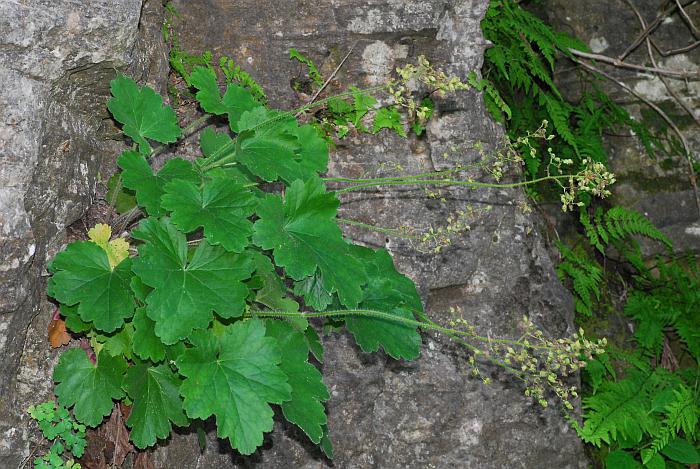Heuchera richardsonii R. Br.
Prairie Alum Root

Native
CC = 6
CW = 3
MOC = 56
© SRTurner
Heuchera richardsonii R. Br.Prairie Alum Root | |
 |
Native CC = 6 CW = 3 MOC = 56 |
© SRTurner |
|
Family - Saxifragaceae Habit - Perennial forb with short, stout rhizomes. Stems - Absent except for inflorescence stalk. Leaves - Basal. Occasional highly reduced bracts alternate on inflorescence stalks. Basal leaves long-petiolate, with petioles densely pubescent with long, spreading hairs having minute glandular tips. Leaf blades roughly circular, to 10 cm, adaxially sparsely hairy to glabrous, abaxially more densely hairy, palmately veined, the margins with several lobes and also more finely toothed or scalloped
Inflorescence - Panicles with numerous flowers, to 100 cm, glabrous to densely hairy with mostly spreading hairs having minute glandular tips, also with scattered minute glandular hairs, especially on the branches and toward the inflorescence tip.
Flowers - Hypanthium at flowering 5-11 mm long, 4-8 mm in diameter, the free portion 2-7 mm long, conspicuously zygomorphic, broadly bell-shaped when fresh, minutely glandular, greenish or reddish-tinged. Sepals 1.5-4.0 mm long, minutely glandular, the sinuses between the sepals relatively broad. Petals 1.5-4.0 mm long, usually minutely glandular, green or white, sometimes pinkish-tinged.
Fruits - Fruits with the body 7.0-14.5 mm long, tapered into the 3.0-4.5 mm long styles. Seeds 0.6-0.9 mm long, ovoid, the surface with fine tubercles or spines. Flowering - April - June. Habitat - Prairies, glades, ledges, rock outcrops in forests, roadsides. Origin - Native to the U.S. Lookalikes - Other species of Heuchera, especially H. americana. Other info. - This alum root can be difficult to distinguish from H. americana. The flowers are slightly larger, and the hypanthia more asymmetric, but these are subtle differences which require experience with both species for accurate application. The difficulty of determination is exacerbated by significant variability in character expression. The plants can be found in diverse habitats which include both open prairie and shaded rock faces. Its range includes the north-central portion of the U.S. and into Canada. Photographs taken at Cooper Hill Conservation Area, Osage County, MO, 5-29-2018 (SRTurner). |